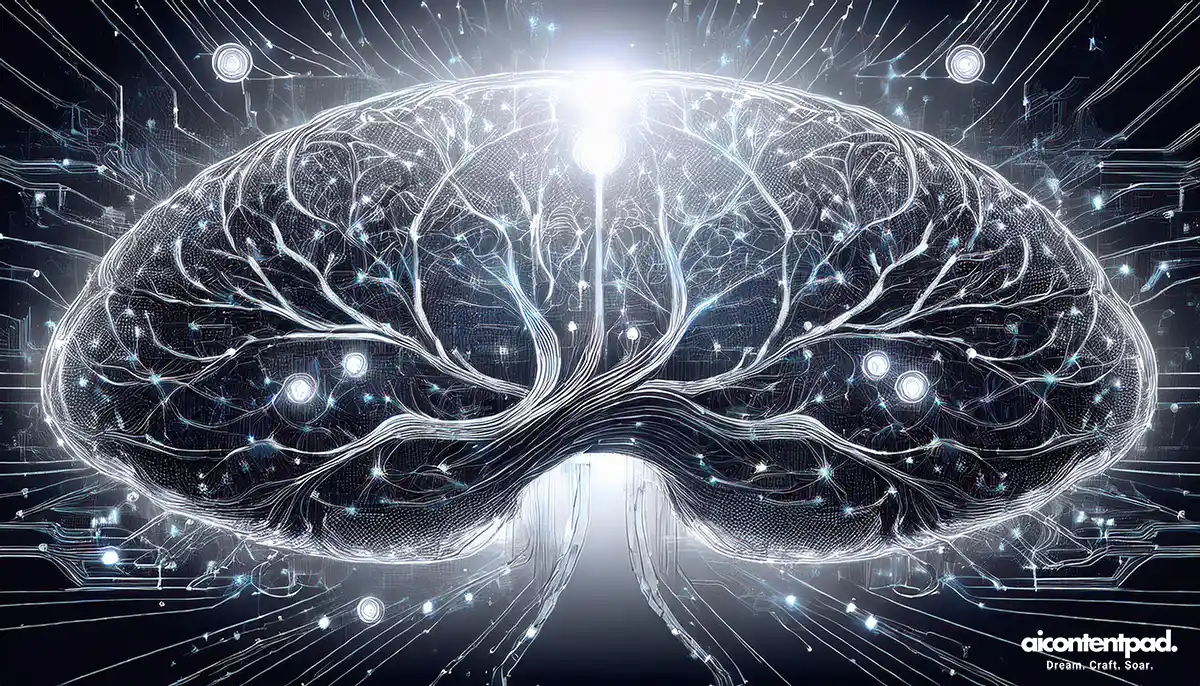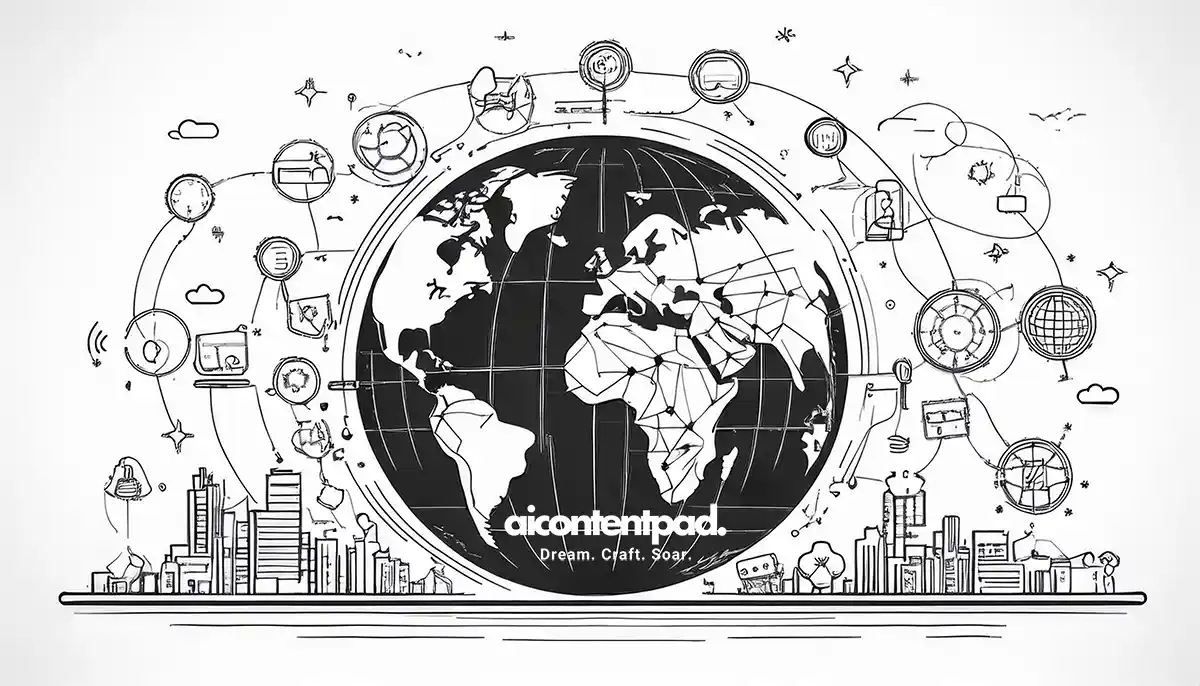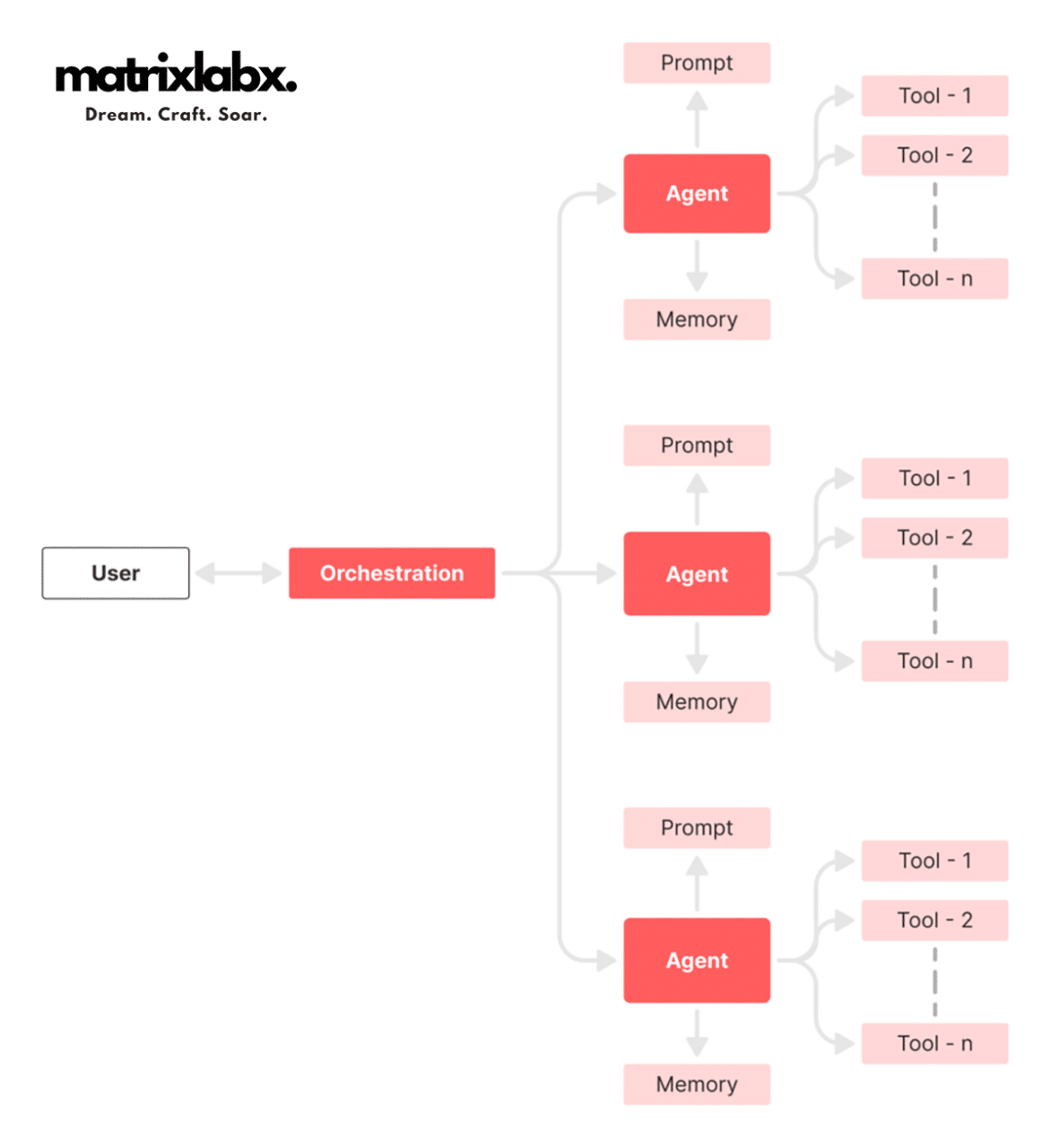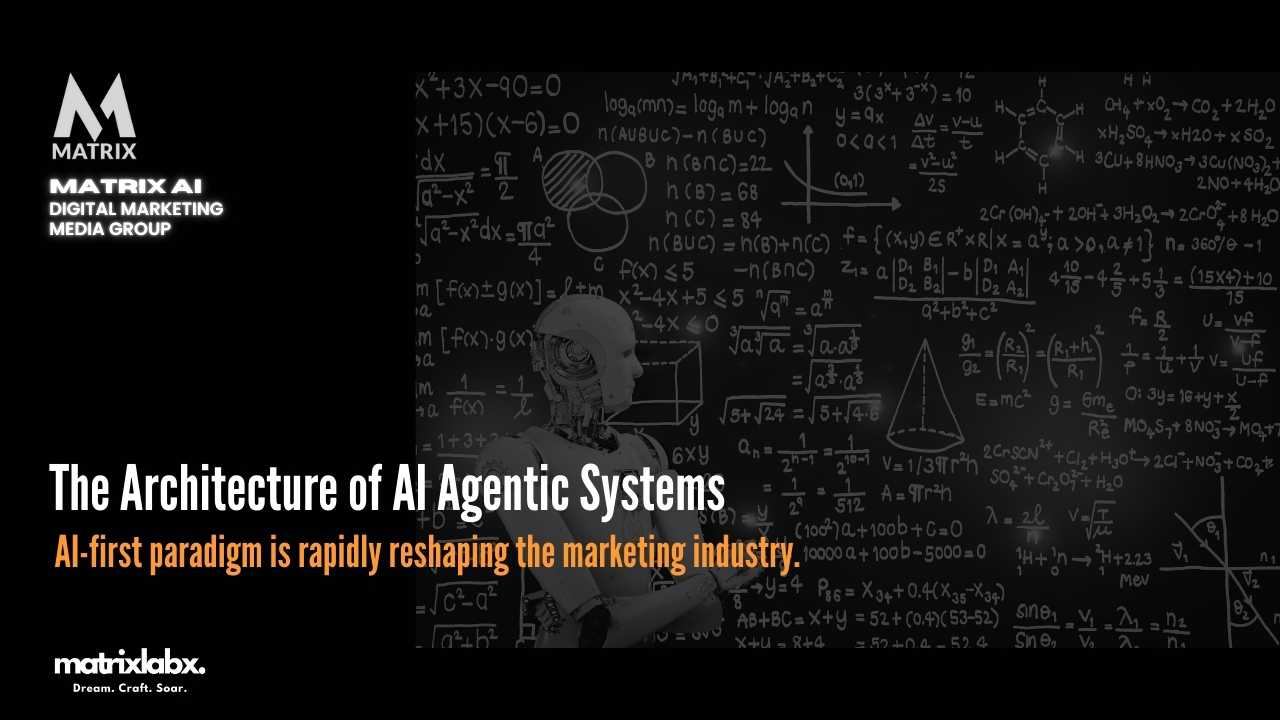Understanding the Components of an AI Agentic System Architecture
The architecture of AI agentic systems, often called AI agent systems or autonomous agent systems, refers to a framework where intelligent software agents work independently to perform tasks, make decisions, and interact with other systems or agents.
Imagine a moment when AI surpasses human intelligence—an unstoppable cascade of self-improvement begins, and each iteration grows exponentially smarter. This acceleration pushes beyond the limits of your imagination, transforming our world instantly.
We stand on the brink of an unprecedented era when the lines between humans and machines blur into a singularity of unimaginable potential.
For marketers, this isn’t just a glimpse of the future—it’s a new playing field where the rules of creativity, engagement, and connection are being rewritten. Are you ready to seize this opportunity and lead your brand into the future?
These architectures vary based on specific applications but generally consist of multiple interacting components that ensure the agents can operate autonomously, perceive their environment, plan actions, and learn from experience.
Below, we will explore the major components of a typical AI agentic system architecture. AI Agentic Systems for Marketing Healthcare Organizations
Architecture of AI Agentic Systems

Revolutionizing Sales and Marketing Operations with AI-First Marketing Platforms
AI agentic systems from MatrixLabX are transforming sales and marketing operations by leveraging AI-first marketing platforms.
These platforms empower businesses to automate repetitive tasks, gain deeper insights into customer behavior, and create personalized marketing campaigns that drive growth and success.
Achieve a Competitive Edge with Precision Market Segmentation and Strategic Positioning
Key Features and Benefits of MatrixLabX and Architecture of AI Agentic Systems:
- Automated Processes: AI agentic systems automate time-consuming tasks such as lead generation, email marketing, and social media management, freeing marketing teams to focus on strategic initiatives.
- Enhanced Customer Insights: By analyzing vast amounts of customer data, AI agentic systems provide valuable insights into customer behavior, preferences, and purchase patterns. These insights enable marketers to tailor their campaigns more effectively.
- Personalized Marketing Campaigns: AI agentic systems enable businesses to create personalized marketing campaigns that resonate with individual customers. This personalization improves engagement, conversion rates, and overall marketing ROI.
- Real-Time Optimization: AI agentic systems continuously monitor campaign performance and make real-time adjustments to optimize results. This ensures that campaigns are always delivering the best possible outcomes.
The distinction between multi-agent systems (MAS) and AI agentic systems lies in their design, functionality, and level of autonomy. While both are based on the concept of “agents”—independent, goal-driven entities—there are key differences in structure, purpose, and technological complexity. Structured AI Outputs: Navigating the Future of Marketing
1. Multi-Agent Systems (MAS)
- Definition: Multi-agent systems are composed of multiple agents working together to solve complex problems or achieve shared objectives. Each agent operates independently but collaborates and communicates with others in the system.
- Purpose: MAS is primarily focused on creating a network of agents that can collectively tackle complex tasks. The goal is often to distribute problem-solving efforts among agents, allowing them to work simultaneously to increase efficiency and handle distributed or large-scale problems.
- Level of Autonomy: MAS agents typically have limited autonomy and follow predefined rules. They are designed to communicate and cooperate based on established protocols but are usually programmed with fixed behaviors.
- Example: In a warehouse management system, multiple agents could be responsible for different tasks (e.g., organizing inventory, tracking shipments, coordinating delivery). These agents operate within a shared environment, each performing a specific role to optimize the workflow.
2. AI Agentic Systems
- Definition: AI agentic systems are built on more advanced AI algorithms and are often designed with more autonomy, adaptability, and intelligence. An AI agentic system doesn’t just follow predefined rules; it learns from data, adapts to changing conditions, and can make decisions independently.
- Purpose: AI agentic systems are focused on creating intelligent agents that can autonomously learn, make decisions, and potentially operate in complex, dynamic environments without human intervention. They’re capable of achieving individual goals while also contributing to larger objectives.
- Level of Autonomy: These systems feature higher levels of autonomy and adaptability. AI agents can modify their behavior based on new data or feedback, improving their performance and decision-making over time.
- Example: AIProdPad or AIContentPad, products from MatrixLabX, are examples of AI agentic systems. These agents adapt their strategies based on user engagement metrics, market trends, and real-time data. They continuously improve their ability to target the right audiences, optimize campaigns, and personalize content autonomously. Architecture of AI Agentic Systems boost sales quickly.
Key Differences
| Aspect | Multi-Agent Systems (MAS) | AI Agentic Systems |
|---|---|---|
| Complexity | Designed for task-specific coordination | Built for high autonomy, learning, and adaptation |
| Goal | Coordination and cooperation among agents | Autonomous decision-making and self-improvement |
| Adaptability | Limited adaptability; follows preset protocols | Highly adaptive, learns from data and environment |
| Application | Distributed problem-solving | Dynamic problem-solving with intelligent behavior |
| Examples | Logistics management, resource allocation | Autonomous marketing, personalization, adaptive content management |
While MAS focuses on agent collaboration with limited adaptability, AI agentic systems prioritize autonomy, intelligence, and the ability to evolve independently—making them well-suited for more complex, dynamic applications like personalized marketing, predictive analytics, and real-time decision-making.
Case Study: Consumer goods manufacturer
CPG, a leading consumer goods manufacturer, implemented MatrixLabX AI agentic systems to streamline its sales and marketing operations. The results were impressive:
- 37% increase in lead generation
- 35% boost in conversion rates
- 50% reduction in marketing costs
AI agentic systems from MatrixLabX are revolutionizing sales and marketing operations by providing AI-first marketing platforms that automate processes, deliver customer insights, and enable personalized campaigns.
By leveraging these technologies, businesses can gain a competitive edge, drive growth, and achieve greater success. AI Blog Post Generation GPT Agent: Unleash the Future of Content Creation
AIContentPad – On-Brand Content
AIContentPad offers numerous advantages to on-brand content and corporate governance. It enables companies to streamline communication, improve compliance, and support decision-making processes through efficient and reliable content generation.
AIContentPad provides a scalable solution that helps companies uphold and exceed governance standards. This ultimately leads to better decision-making, stronger regulatory compliance, and enhanced organizational accountability.
1. Environment Interface
The environment interface is crucial in managing an agent’s interactions with its surroundings. It is the component that bridges the external environment and the agent’s internal processing. This interface comprises sensors and effectors, allowing an agent to perceive and influence its environment.
Sensors are devices or software components that allow an agent to collect data about its environment. In the context of a software-based agent, sensors can be physical, such as cameras, microphones, and temperature sensors, or virtual, like network monitors. The purpose of these sensors is to gather raw information representing the state of the external world.
Effectors are responsible for enabling the agent to act within its environment. These actions can be physical movements in robotics or more abstract actions, such as sending commands over a network. For example, effectors could include wheels, motors, or robotic arms in a robotic agent. In contrast, in a software agent, effectors might involve executing commands that modify a database or communicate with another system.
Ultimately, the environment interface is the initial point of interaction for any AI agentic system. The quality of data gathered, and the efficacy of actions taken depend heavily on this interface, directly impacting the agent’s ability to operate effectively in real-time or simulated environments.
2. Perception Module and Architecture of AI Agentic Systems
The perception module converts raw sensor data into meaningful information that the agent can use to make decisions. This module involves feature extraction, data processing, and the interpretation of sensory inputs to form an internal representation of the environment.
Feature extraction is a key aspect of this module, where the data collected from sensors is analyzed to identify useful attributes. For instance, feature extraction might involve identifying edges, colors, and shapes from images in a visual data context, which is essential for object detection and recognition tasks. For time-series data, feature extraction could detect patterns and trendsthat are useful for prediction.
The perception module often relies on advanced technologies like computer vision, natural language processing (NLP), and signal processing to derive meaning from different data types. For example, an agent might use computer vision to recognize objects in a self-driving car environment or NLP to understand commands in a virtual assistant setting. Neural networks are commonly used for these tasks because they can learn complex representations from large amounts of data, significantly enhancing an agent’s ability to interpret the environment accurately.
Ultimately, the perception module gives the agent a more abstract and meaningful representation of its environment, allowing it to proceed to the reasoning and planning stages. This abstraction is essential for reducing complexity, enabling the agent to operate more efficiently and effectively. What is Neuro-Symbolic AI for Precision Marketing?
3. Knowledge Base and Architecture of AI Agentic Systems

The knowledge base is the core repository of all the information the agent uses to reason, make decisions, and learn. It encompasses different types of knowledge, including domain-specific knowledge, world knowledge, and rules and policies that guide the agent’s actions.
Domain-specific knowledge is the specialized information about the specific environment or problem the agent is designed to solve. For example, a medical diagnostic agent might contain knowledge about symptoms, diseases, and treatments. This knowledge allows the agent to understand its domain’s nuances and requirements and make more informed decisions.
World knowledge involves general information about how things work. For instance, an autonomous vehicle agent must understand general concepts like road rules, the structure of intersections, and pedestrian behavior. This general knowledge enables agents to operate in diverse environments where domain-specific details alone would not suffice.
Rules and policies dictate how the agent should behave under specific conditions. These rules can be represented in various forms, such as if-then statements, ontologies, or probabilistic models providing a decision-making framework. The knowledge base can be updated dynamically as the agent learns, thus enhancing its reasoning capabilities over time and adapting to changes in the environment.
4. Reasoning and Planning Module
The reasoning and planning module is one of the most critical components of an AI agentic system. This module is responsible for making inferences from the knowledge base and determining the most appropriate sequence of actions the agent should undertake to achieve its objectives.
Reasoning allows the agent to conclude available knowledge. It can use deductive logic, where conclusions are drawn based on a set of known premises, or it might use probabilistic approaches, where decisions are based on the likelihood of outcomes. This type of reasoning is particularly useful in uncertain environments or where data might be incomplete.
The planning aspect of this module involves creating a sequence of actions to achieve a particular goal. This requires not only understanding the goal itself but also considering the environment’s constraints and conditions. Techniques used in planning include search algorithms such as A* or Dijkstra’s algorithm, optimization techniques, and reinforcement learning for agents that need to adapt their plans based on continuous feedback from the environment.
This module combines reasoning with effective planning to ensure the agent can develop and execute a strategy to achieve its goals while adapting dynamically to changes or unexpected obstacles. This flexibility is vital for autonomous agents operating in unpredictable environments.
5. Goal and Task Management
Goal and task management ensures the agent remains focused on achieving its objectives. This module is responsible for setting, prioritizing, and tracking the progress of the agent’s goals.
Agents may have multiple goals, each requiring different actions or behaviors. The goal management system prioritizes these goals, ensuring the agent focuses on the most important tasks. This might involve trade-offs, such as choosing between a short-term task that provides immediate rewards and a longer-term task that is more beneficial overall. Such prioritization is managed using frameworks like Hierarchical Task Networks (HTNs) or Goal-Directed Behavior Trees.
Tasks can also be decomposed into sub-tasks that can be managed independently. This decomposition is useful for solving complex problems, allowing the agent to break down a large goal into manageable parts. For example, an autonomous robot delivering an item may decompose the goal into sub-tasks like mapping a path, navigating obstacles, and delivering the object to the destination.
Effective goal and task management is crucial for ensuring that agents can achieve complex objectives in an organized and efficient manner, especially in scenarios where multiple tasks must be handled concurrently or when new goals emerge dynamically during execution. What is an AI Content Assessment?
Achieve a Competitive Edge with Precision Market Segmentation and Strategic Positioning
6. Action and Control Module
The action and control module executes the plans generated by the reasoning and planning module. This module determines when and how actions should be taken to achieve the agent’s goals and monitors the execution to ensure that everything proceeds as intended.
The control aspect of this module is particularly important for managing sequences of actions that involve dependencies or require precise timing. For instance, in a robotic system, control algorithms ensure that the robot’s joints move in the correct sequence to perform a task, such as picking up an object. In software agents, the control module might decide when specific commands should be sent to external systems or when internal actions should be initiated.
During execution, the control module monitors the outcomes of each action to ensure that they align with expectations. If deviations occur, such as an unexpected obstacle, the control module can take corrective actions by replanning or modifying the execution sequence. This ability to adapt actions on the fly is crucial for ensuring that the agent can handle real-world unpredictability.
Overall, the action and control module acts as the agent’s link to its environment, enabling it to carry out the actions necessary to fulfill its objectives while dynamically responding to changes.
7. Learning Module and Architecture of AI Agentic Systems

The learning module is what allows an AI agent to improve over time. By learning from its experiences, an agent can refine its strategies, enhance its knowledge base, and ultimately become more effective in achieving its goals.
Learning can be categorized into three main types: Supervised, Unsupervised, and Reinforcement. In supervised learning, the agent learns from labeled data, such as images or datasets, allowing it to recognize patterns or make predictions. In unsupervised learning, the agent identifies patterns and relationships in data without prior labeling, which is useful for exploratory analysis or clustering tasks.
Reinforcement learning plays a key role in autonomous agentic systems, especially those that operate in dynamic environments. In reinforcement learning, an agent learns by interacting with its environment and receiving feedback through rewards or penalties. This allows the agent to refine its strategies by associating actions with positive outcomes, gradually improving its ability to make decisions that lead to successful goal attainment.
Ultimately, the learning module is essential for creating adaptive and resilient agents. It allows the agent to adjust behavior in response to changing conditions, new tasks, or updated goals, enabling long-term success in complex and unpredictable environments.
8. Communication Module
The communication module becomes critically important in systems involving multiple agents. This module enables agents to exchange information, collaborate on tasks, and negotiate in competitive environments.
Agents use messages to share information about their state, goals, and plans with other agents. The communication protocol ensures that all agents involved understand these messages correctly. Popular protocols include KQML (Knowledge Query and Manipulation Language), which helps agents communicate intentions, or more advanced multi-agent communication frameworks that support negotiation, information sharing, and teamwork.
Communication is particularly relevant in multi-agent systems (MAS), where multiple autonomous agents collaborate to achieve a common objective. For instance, different agents manage traffic signals, parking, and public transportation in a smart city context. To ensure seamless city operation, these agents must communicate effectively, coordinating decisions that benefit the system.
This module fosters effective communication, enabling agents to leverage the power of collaboration and teamwork and achieve tasks that would be impossible for a single agent to handle alone.
70% of agencies need help integrating AI solutions.
70% of agencies need help integrating AI solutions into their tech stack, citing a lack of interoperability as a major barrier. 85% of marketing agencies need more in-house expertise to manage and deploy multi-AI agent systems effectively.
9. Behavior Generation
The behavior generation module produces the appropriate responses to the situation that the agent perceives. Behavior generation can vary significantly based on the agent’s design—some agents react directly to stimuli, while others take more deliberate and calculated actions.
In reactive agents, behavior is often a direct response to environmental changes, allowing for fast, low-complexity decisions. For example, a robotic vacuum cleaner changes its movement when it bumps into an obstacle. In contrast, deliberative agents take a more thought-out approach. These agents generate behavior after considering their current goals, the state of their environment, and the most optimal path to achieving their objectives.
Behavior generation involves balancing being reactive to immediate environmental changes and proactively working toward long-term objectives. This requires integrating real-time environmental data and long-term goal-directed planning, enabling agents to act effectively in predictable and unpredictable environments.
10. Architecture Styles
The design of AI agentic systems can take on different architectural styles, each suited to a different environment or application requirement. The choice of architecture significantly influences how an agent processes information, makes decisions, and interacts with its environment.

Reactive Architectures are designed to be fast and lightweight, with minimal processing. They respond directly to environmental stimuli without maintaining an internal model of the world. This simplicity makes them suitable for quick-response scenarios, such as in simple robots or basic automation systems.
Deliberative Architectures, however, include explicit models of the agent’s goals, plans, and the world around them. This model allows the agent to make more informed decisions, plan long-term actions, and reason about the potential consequences of different strategies. Deliberative agents, such as autonomous vehicles, are typically used in complex scenarios where understanding and foresight are crucial.
Hybrid Architectures combine the strengths of both reactive and deliberative approaches, allowing agents to respond quickly to immediate stimuli while planning long-term actions. These architectures are well-suited to partly predictable and partly unpredictable environments, providing a good balance between responsiveness and goal-oriented behavior.
Finally, Multi-Agent Systems (MAS) consist of multiple interacting agents that can either collaborate or compete. These systems can achieve more complex goals by distributing responsibilities among different agents, each with its specific sub-architecture tailored to particular tasks.
Marketing is evolving. The world moves faster every day, and marketing teams are under pressure to deliver personalized, impactful campaigns at lightning speed.
Example: BDI (Belief-Desire-Intention) Architecture
One well-known model for agentic systems is the BDI (Belief-Desire-Intention) architecture, designed to provide a framework for sophisticated decision-making and goal-directed behaviors.
Beliefs represent the agent’s perception of the environment, providing information that the agent has gathered from sensors or other data sources. These beliefs form the basis of how the agent understands its current state and circumstances.
Desires represent the objectives that the agent aims to achieve. They outline what the agent wants to accomplish, guiding its decision-making process toward goal fulfillment. Desires can vary depending on the agent’s environment and current state and may include short-term and long-term objectives.
Intentions are the commitments that the agent makes to achieve its desires. They represent the plans that the agent is actively pursuing. By focusing on a subset of its desires, the agent can allocate resources effectively and ensure that its actions are purposeful and aligned with its goals.
The BDI model is popular for applications requiring complex goal-driven behavior, such as personal digital assistants, autonomous vehicles, and industrial automation, as it provides a structured way for agents to think, decide, and act.
System Flow of an AI Agentic System
The entire AI agentic system can be visualized as operating in a continuous loop:
- Perception: The agent first collects information from its environment using sensors. This step provides raw data that serves as the basis for understanding the current situation.
- Reasoning and Planning: Using the perception data, the agent references its knowledge base and processes the information to develop a strategy or plan. This may involve uncertain decision-making, considering both immediate conditions and long-term goals.
- Action Execution: Once a plan is formulated, it is executed via the action and control module, directly affecting the environment. During execution, the control system ensures that each action is performed correctly and adjusts as needed if deviations occur.
- Learning and Updating: Finally, the agent reviews the outcomes of its actions to learn and improve. Feedback updates the knowledge base, ensuring that future decisions and plans are based on the most up-to-date information.
This iterative process allows AI agents to operate autonomously, continuously adapt to new information, and optimize their behavior over time.

Key Characteristics of AI Agentic System Architectures
AI agentic systems exhibit several key characteristics that make them uniquely capable of operating in complex, dynamic environments.
- Autonomy: One of the defining characteristics of AI agents is their ability to operate independently without requiring constant human intervention. This autonomy allows them to make decisions, execute actions, and achieve goals independently.
- Reactivity: AI agents are capable of perceiving changes in their environment and reacting in real time. This ability is critical for applications like robotics, where environments are often unpredictable, and quick responses are essential.
- Proactiveness: Beyond merely reacting to stimuli, AI agents are proactive. They can plan actions ahead of time, set goals, and make decisions to achieve those goals, demonstrating long-term focus and initiative.
- Social Ability: AI agents often need to interact with other agents or human users. Their social ability enables them to communicate effectively, collaborate on tasks, or negotiate in competitive scenarios, making them more versatile in environments that require teamwork or user interaction.
Designed specifically for marketing departments, these specialized AI agents represent a significant leap forward. They combine AI Collaboration, Metacognition, Specialized Agents, and Neuro-Symbolic Reasoning to achieve next-level intelligence.
This unique architecture allows AI to operate with enhanced self-awareness, specialized skillsets, and human-like reasoning, transforming how marketing teams achieve their goals.
“Domain-specific AI Agents are exactly what marketing managers have been asking for—faster, cheaper, and better solutions to meet the demands of modern marketing,” said Jessica Smith, AI Solutions Lead at MMG. “These intelligent agents automate and optimize processes with precision, allowing marketing teams to focus on creativity and strategy rather than spending countless hours troubleshooting or managing outdated workflows.”
The Skill Gap: Why 85% of Marketers Are Not Ready
The Skill Gap: Why 85% of Marketers Are Not Ready highlights the urgent need for upskilling in a rapidly evolving digital landscape. Advanced technologies like AI, data analytics, and automation are outpacing traditional marketing expertise, leaving most professionals unprepared to adapt and compete effectively.
Applications
The applications of AI agentic systems are diverse, ranging across multiple domains, each requiring different capabilities and levels of autonomy.
- Robotics: In robotics, AI agents are responsible for navigation, manipulation, and interaction with their physical environment. Examples include robotic vacuum cleaners, delivery drones, and industrial robotic arms that perform precision tasks.
- Financial Trading Systems: In the financial industry, AI agentic systems automate trading, where agents analyze market conditions and autonomously make buy or sell decisions. These systems must respond to real-time market changes requiring reactivity and sophisticated planning.
- Healthcare: AI agents are used as personal assistants, monitoring patient data, reminding patients to take medication, or even predicting health issues before they become critical. They can also support healthcare professionals by providing real-time analysis of patient conditions.
- Gaming: AI agents control non-playable characters (NPCs) to create a dynamic, immersive experience. These NPCs adapt to player actions, making the gaming environment more challenging and engaging.
- Replacing Traditional CRM and Marketing Automation Platforms: MatrixLabX AI agentic systems are increasingly replacing traditional CRM and marketing automation platforms, offering a more dynamic, adaptive, and autonomous approach to customer engagement and marketing. Unlike conventional systems that rely on static rules and manual intervention, MatrixLabX agents learn from real-time customer interactions, enabling continuously evolving personalized marketing strategies. These agents integrate data from multiple channels, provide predictive insights, and automate interactions in previously impossible ways with older platforms. The result is a marketing and customer relationship management process that is more efficient and responsive to customer needs, creating a significantly improved user experience.
Empowering Intelligent Marketing with Multi-Agent RAG Systems
A New Era of AI with Matrix Marketing Group and MatrixLabX
Matrix Marketing Group, in partnership with MatrixLabX, is redefining the future of marketing through next-generation AI capabilities powered by Multi-Agent RAG Systems. This revolutionary approach elevates traditional AI, providing brands with an adaptable, deeply intelligent system for solving marketing challenges and seizing opportunities. Learn more.
Conclusion on Architecture of AI Agentic Systems
The system architecture of AI agentic systems is a sophisticated arrangement of perception, knowledge representation, decision-making, and action mechanisms that work together to achieve autonomy and intelligence.
These architectures enable agents to operate independently, adapt to new situations, learn from experience, and collaborate or compete as needed.
Depending on the application domain, agentic systems can range from simple reactive models to highly complex hybrid architectures with advanced reasoning, planning, and learning capabilities.
As AI technology advances, these agentic systems will play a crucial role in various fields, enhancing automation, improving decision-making, and enabling more adaptive, intelligent interactions with the world. AI Product Management: Why Software Product Managers Need to Understand AI and Machine Learning




